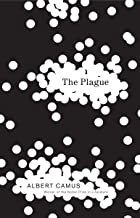The Plague, Albert Camus 1947
What could be more appropriate for our COVID19 pandemic than reading Camus’ classic novel, The Plague. Written shortly after the end of WWII, the story is set in Oran, a city of 200,000 on the coast of French Algeria. When rats begin to die and a few individuals turn up with fever, swollen lymph nodes, and skin lesions, the narrator, Dr. Rieux begins to worry about plague but his colleagues and the authorities are hesitant to worry the population and disrupt the local economy, so they defer difficult decisions. Sound familiar? Science and medicine are sidelined until the number of deaths becomes intolerable at which point the epidemic is out of control. Schools and government buildings are pressed into service as hospitals (surge capacity), stores close and food shortages threaten (supply chain disruption), hotels are empty and train and boat service no longer function (the end of the travel industry), lack of equipment threatens patients and caregivers and health care workers begin to sicken and die (no PPE), visitors are not allowed in hospitals and funerals are limited to a few family members, newspapers publish the weekly death tolls, civil unrest grows as skirmishes break out between the police and those trying to break the quarantine, and finally the ‘curve flattens’ (yes, the same term was used in 1947 as Tony Fauci used in 2020) and the epidemic eventually ends. The parallels to our current situation are eerie, and Camus’ observations about the importance of ‘common decency’ as the only means of fighting the plague are worrisome for the current time given our divisive leadership and political strife. The characters are wonderfully drawn and realistically portrayed in their roles during the crisis—the heroic doctor, the anti-capital punishment idealistic citizen volunteer, the visiting reporter who gives up trying to escape and pitches in as a health care worker, the accused criminal who enjoys the fact that others now share his future fate. Camus shows how indifferent the world is to our individual situations, aspirations, and dreams. We are all dancing along on the knife edge of catastrophe and death. Not fun, but a superb addition to pandemic reading by the Nobel Prize winner from 1957 who tragically and ironically died in an automobile accident at the age of 47. As Adam Gopnik wrote in his recent TNY review: The microbe has no meaning; we seek to create one in the chaos it brings . . . The plague, as Camus insisted, exposes existing fractures in societies, in class structure and individual character; under stress, we see who we really are.” May our own time’s pandemic quickly flatten and then disappear and leave us determined to address those societal inequities that it has exposed.



